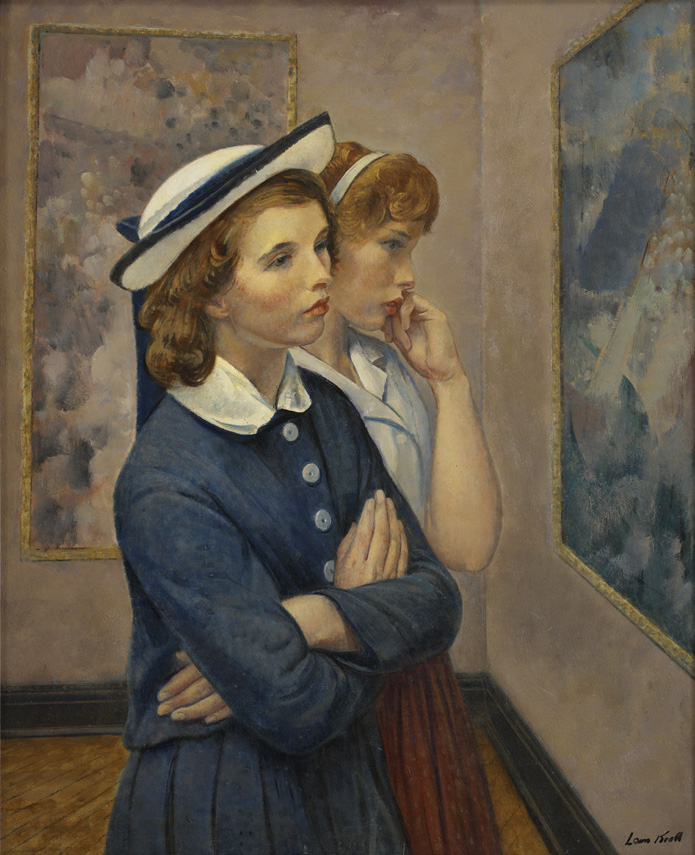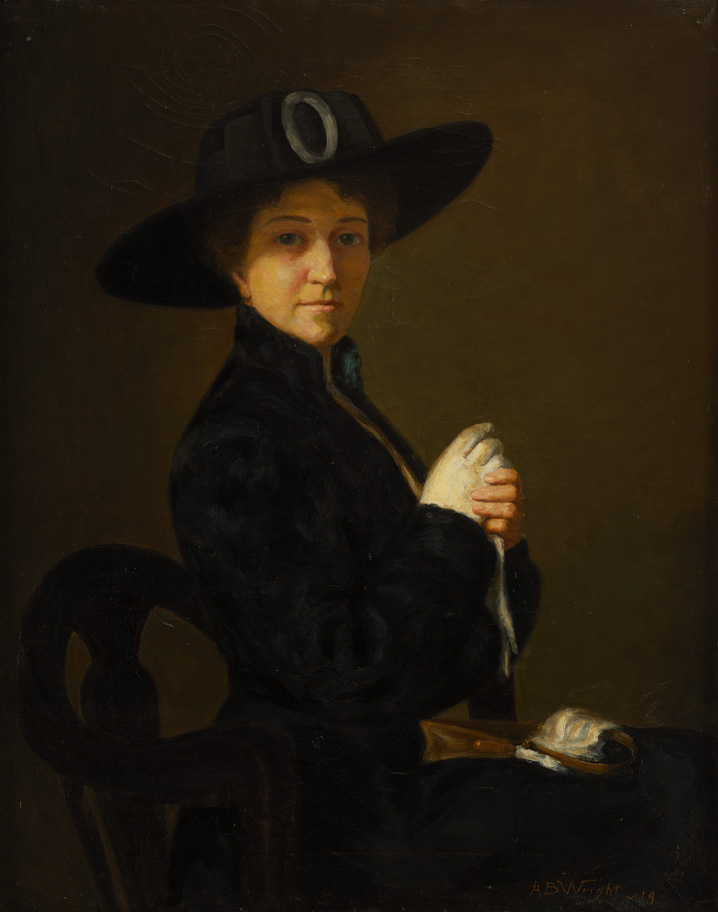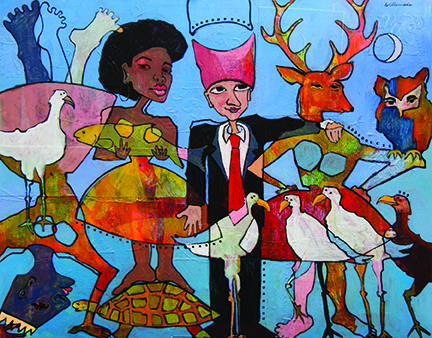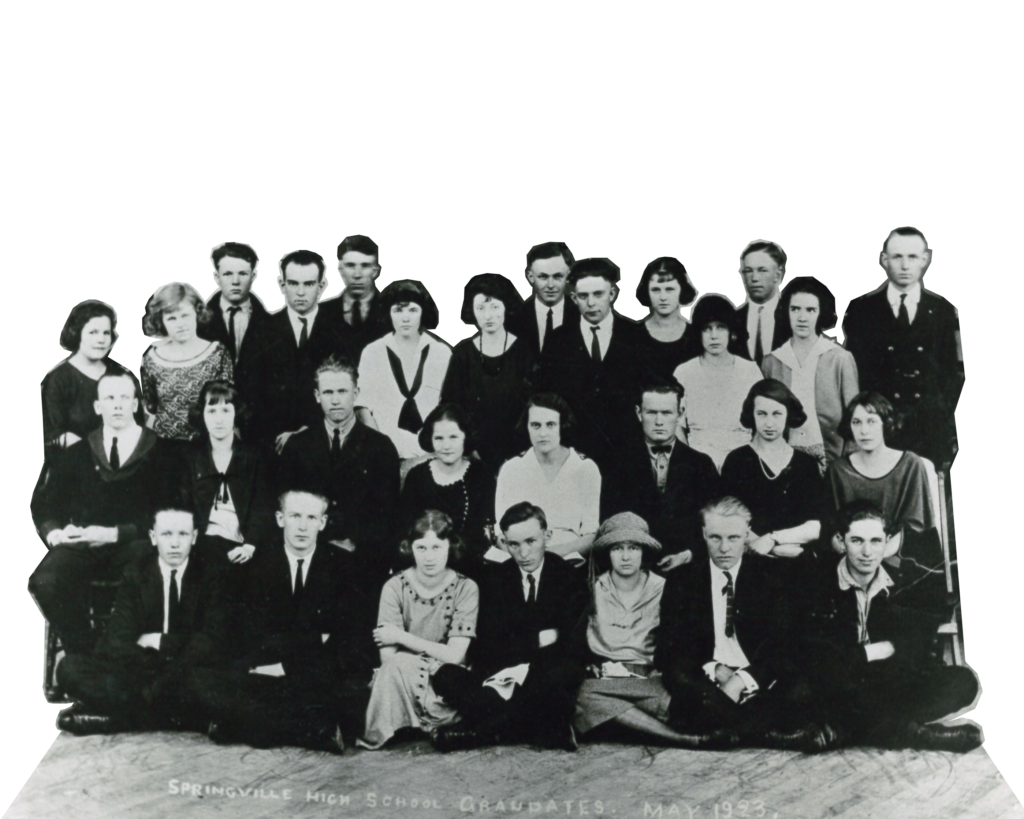When it comes to the founding of Utah’s tremendous art movement, its own “this is the place” moment occurred not in Salt Lake City nor Provo. Spanish Fork or Payson but instead in Springville, just about the same time as the town was being established in the 1850s.
As Vern Swanson, retired director of the Springville Museum of Art, noted in a written history, “The first intimations of an Art Movement came in 1848, two years before Springville was founded. While still in Winter Quarters, Nebraska, pioneer artist Philo Dibble (1806-1895), an early Springville settler, envisioned ‘the creation of a fine arts museum or gallery to be established for the benefit of the Mormon people.’” Dibble moved to Springville in 1858. “Through his panoramic painting of religious and historical subjects, his exhibitions of art and death masks of Joseph and Hyrum Smith, as well as magic-lantern slide presentations of famous paintings,” Swanson explained, “Dibble created a climate of interest for the visual fine arts in Springville within eight years of the founding of the City.” Swanson related a story from one of Dibble’s relatives: “According to a grand-niece, once during his rounds through town, Dibble plunged his sacred ‘Cane of the Martyrdom’ into the ground at the corner of First East and Fourth South and said, ‘The school gallery shall be here.’”
In the opening of the splendid short documentary film, Spirit of the Art City, produced by The Plains studio, Swanson mentioned Dibble as the spark that led eventually to the occasion of this year’s historical undertaking. The Springville Museum of Art marks the milestone with a major exhibition, Salon 100: A Retrospective of 100 Spring Salons and the Students that Built Art City.
The show opened simultaneously in late April, along with this past spring’s 100th annual salon, and the Salon 100 exhibition will continue through June 2025. The show comprehensively lays out the 100 years of the history of the salon in an organized and lucid fashion, especially in showing how the artworks selected for the salon have evolved in medium technique, style, aesthetics, subject treatment and other elements through every decade.
As Utah’s first art museum, Springville’s initial collection grew as local high school students purchased paintings and sculpture through an ‘Art Queen’ festival. Each student paid a penny to vote and the student with the most votes was named queen, with the funds used to purchase art for the museum. High school students led efforts to put on a Parisian-style salon exhibition, beginning in 1922 and which has continued annually each spring (with the exception of two years during World War II). As noted in the documentary short film, which is directed by Jared Jakins and H.B. Phillips, the museum now has “2,646 works of art and counting.”
Running a bit under 17 minutes, the film is fascinating in celebrating perhaps the Utah Enlightenment’s longest running enterprise of artistic excellence, which also put the state at the forefront as an art education pioneer, ahead of virtually every other state in the U.S. by similar measure. For example, the Springville museum has been instrumental in organizing the Utah All-State High School Art Show annually since 1971, which is coordinated in conjunction with the Utah Division of Arts and Museums. It is among the nation’s largest and longest-running student art shows of its kind.
From the earliest days, the commitment of Springville locals to art never wavered. “They prioritized art even when they couldn’t get enough to eat,” Emily Larsen, current director, said in the film. Among the earliest artists who gave the primordial roots for the art salon in Springville were painter John Hafen (1856-1910) and sculptor Cyrus Dallin (1861-1944), who was born in Springville and eventually settled in Massachusetts. A Swiss native who came to Utah at the age of six, Hafen became a cultural ambassador of sorts for The Church of Jesus Christ of Latter-Day Saints, by organizing an ‘art mission’ where Utah artists studied at a Parisian academy. Later, Hafen eventually settled in Springville with his family. He painted a mural of hollyhocks on a cement wall at his home, which still stands today. The mural canvas was removed and framed, where it now resides at the Springville museum.
Described by Swanson as an Emersonian whose paintings captured the grandeur and beauty of Utah’s natural landscapes, Hafen donated a painting to the Springville High School and encouraged sculptor Cyrus Dallin to donate artwork, along with other Utah artists. Hafen donated an oil painting Mountain Stream in 1903 and Dallin, who had returned to Utah for a lecture to Springville students that same year, was so moved that he donated the plaster model for one of his Paul Revere bronze sculptures to the Springville High School. In the documentary, Swanson talked about how Hafen brought back a salon culture from Paris and promulgated it in Springville, which made him “an instant celebrity.” Quoting Hafen, Swanson said he believed that “art is not a luxury; it is a necessity.”
The donations launched a movement among the students that has continued annually to this day. By the 1920s, as Larsen explained in the documentary, no high school in the U.S. could claim to have as “good an art collection” as what was found in Springville.

The students raised funds to purchase a piece for the permanent collection from artists who were at a caliber of national recognition and each class nominated an ‘art queen.’ The class which raised the most money would have the honors of unveiling their selected artwork to become part of the permanent collection. As several commented in the film, the students became incredibly good at knowing what constituted a high caliber in the art that interested them. And, Swanson mentioned, “Why would anybody in their right mind send a valuable painting to a high school in the wilds of the west because Mae Huntington asked them to do it.” Huntington, a devotee of Hafen and Dallin, was an English teacher at Springville High School, and as Swanson explained, she took stewardship of the movement “as if it were her baby.” For more than three decades, Hungtington dutifully wrote articles and letters by hand annually for the salon exhibition, including the calls for entries that went out to artists and dealers. The salon took off, according to Swanson, “because of a magic moment where you have all the right pieces in place.”

The first spring salon was held in 1922, featuring 200 paintings. Wayne Johnson, the high school art teacher and curator, was described as setting the standard of “nothing mediocre.” As an accompanying book for the Salon 100 exhibition noted, “Every nook and cranny of the high school was filled with art.” Other prominent donors who helped anchor the footing of the salon event were Dr. George Smart and his wife, Emma, who gave major artworks in 1925, valued at $25,000 at the time ($454,000 when adjusted for inflation).
The community’s dedication to art propelled the annual salon from the high school’s halls to a full-fledged museum in 1937 and until the late 1960s the students and faculty of Springville High School hung and organized the annual exhibition, which regularly recorded more than 50,000 annual visitors. For the last 40 years it has become the premier exhibition of art by living Utah artists, featuring 200-plus works by Utah’s best artists in a variety of mediums, styles and subject matters.
Some of the greatest names in 20th century American art knew of the Springville salon from its early years, including Thomas Hart Benton, Edward Hopper. Georgia O’Keeffe, Walt Disney, Norman Rockwell and Maynard Dixon. Swanson added that, at one time, it was the largest nationally represented art show between Kansas City and San Francisco. Springville was proclaimed as Art City, by gubernatorial proclamation.

Jorge Rojas, one of Utah’s internationally known artists today, said the salon was “as powerful as going to church or temple.” Likewise, today’s Springville High School students such as Magdalena Márquez (Class of 2025), one of the student committee members for the salon, recalled, “I remember the first time I visited the museum was for a field trip for one of my art classes. On that trip, I learned about the history of the museum and its significance to Springville. It was such a unique story that intrigued me.” She added, “Being a part of some of the museum’s committees has been a great experience. I love the idea of the museum and the high school rekindling the connection they once had. I hope future students appreciate the history so this connection continues to develop in the future.”
Brian Kershisnik, an artist who submitted work unsuccessfully seven times before being finally accepted into the salon in 2016, said everything about the building is exceptional including the floor tiles which are among countless elements that emphasize the museum’s unique appeal as a place for cultural veneration. Swanson added, “the sanctity of this building is palpable.”
Micah Christensen, an art historian and scholar of European and American art who has spoken to many artists about the larger social roles and functions of the arts in communities, described the salon as Springville’s art version of the Super Bowl. In the documentary, he said, “Springville has probably more art in their homes per capita than anywhere else I know.” He added through many decades, students presciently understood the significance of legacy and of being something more than a footnote in a history book. “They will be remembered for the art that is in the museum and this idea of purifying young minds through good beautiful things really does make a huge difference in the community. That is not something that just happened by chance. That happened because this is a culture who has empowered them.”

EXAMPLES OF WORK FEATURED IN SALON 100
One of the first paintings Springville students purchased, came in 1922. It was a 1919 painting Lady in Black: Margaret Hamilton, by Alma Brockerman Wright, who would lead art schools at Brigham Young College in Logan (then LDS College) and The University of Utah.
In 1928, students in the junior class purchased Moonrise in the Canyon, Moab, Utah by Sven Birger Sandzen, a Swedish native who was based at Bethany College in Kansas but spent his summers during the 1920s, giving art lectures at schools in the west. He made side trips to the heart of Utah’s Red Rock landscapes including Bryce, Zion and Canyonlands national parks, where he recreated them on canvas using reds and blues in high-key hues and relied on layers short but still defined brushstrokes that generated a dense impasto feel to the landscapes, as noted in a catalogue which was part of an exhibition at the Utah Museum of Fine Arts in 2010.
Pick a year and every accessed work is, as the original organizers of the salon encouraged, of especially high caliber. In 1947, Springville Junior High School seventh graders selected Curtain Time Salt Lake Theatre by Cornelius Salisbury. A painter and an actor, he was affiliated with the former Salt Lake Theatre, which was demolisted in 1928, capturing the memory of a performing arts landmark for posterity. Incidentally, another version of the painting (in the Springville collection) is hanging in Pioneer Memorial Theatre at The University of Utah.

In 1953, Springville High School seniors purchased Sudanese by Farrell Reuben Collett, who was a high school art instructor in Ogden before eventually becoming chair of Weber College’s art program (now known as Weber State University). In the 1970s, he had a solo art show at the Utah Museum of Natural History and later was received one of the Governor’s Awards in the Arts.
Springville’s Class of 1958 purchased Navajo Girls and “Naki Deezht two sisters Navajo” by Fremont F. Ellis, a Montana native who worked in the New Mexico arts community for more than six decades. Ellis’ biography is unusual because he had very little formal education of any kind because his family moved frequently from one mining town to another. But, a trip to the Metropolitan Museum of Art in New York City made an indelible mark on him, as he painted copies of the artworks he had seen. He eventually trained as an optometrist but after his business failed and eventually moved from Texas to New Mexico and to California and then back again jn New Mexico, where he became a photographer.
There he became friends with painters Josef Bakos, Walter Mruk, Will Shuster, and Willard Nash and the group established Los Cinco Pintores, a modernist art society in Santa Fe. But as his biographical sketch indicates, “Ellis was never truly a modern painter, tending towards a more realistic style with his own curiously tinted palette. To achieve the right look, Ellis took photographs of the scenes he wished to paint with a variety of different lenses and techniques, and then recreated the shifted color palette of the photographs on paper.”

A gift in 1963 from the Springville High School juniors, Dark Garden by Edward Howard Betts, highlights the skill and quality which defined the career of a Yonkers, New York native who eventually settled in Maine. His work was exhibited in five Corcoran Biennials, and he became a wellxknown author of books on painting landscapes and seascapes in watercolor and acrylic. Students from the Class of 1965 purchased Girls at the Exhibition by Leon Kroll, an artist who accumulated many major prizes for his work during his long career. This work was created in 1964, when Kroll. a New York City native who lived and worked in Massachusetts, was 80. Author Jerome Myers wrote of Kroll in his 1940 book Artist in Manhattan that he was “a fluent performer in many branches of art, his convictions have remained unshaken by the extremists; he has consistently carried his classic banner through the turmoil of modernism. Leon Kroll’s success is to be respected. Personally, I have always found him a gallant adversary in argument, an artist who has captured many hearts as well as many prizes.”
Likewise, the Seventies brought equally exceptional works such as Foothills, Sunset and Night by Robert Mullen (acquired in 1973) and Reflective Involvement, a brass sculpture, by Travis D. Crowther (acquired in 1975). A biology student and Vermont native, Mullen was hired by his professors to provide illustrations for their peer-reviewed work and his skills were sought so widely that he was encouraged to become a professional illustrator. He not only eschewed such invitations but he also declined to pursue studies for a legal career, even as he had received 26 offers from law schools from around the country. He moved to Manhattan in the 1940s where he worked as a freelance artist and later he won the Vermont Duck Stamp Competition in 1994, on his first try.

Indeed, the salon tradition has not wavered during the 2000s. A gift from Anthony’s Fine Art and Antiques in Salt Lake City, Sampson Before the Apophysis of the Philistines (acquired in 2006) by Joseph Franklin Brickey is one of the strongest examples of religiously inspired artworks represented in the exhibition. “I am an artist first for God’s sake, then for art’s sake. I believe art must both measure up in the museums and capture the common heart. The greatest art is that which generates the greatest good,” Brickey wrote in his artistic statement. Brickey’s words resonate with the resilience that can be traced to the first groups of Springville High School who took it upon themselves to be forever reliable stewards of the art salon tradition. “My art is not just for my fellow art community. My art is for my fellow man. It is for all lovers of truth and beauty, for discerning minds and hearts, no matter their artistic background or education. They may be from families anywhere in this wide world, living in wealth or in extreme poverty. They may know nothing of my artistic process, and be totally unaware of artistic issues and formal elements of art. But they love art. They love it for the most important reasons. They love it for the same reasons I love it: for its power to touch the deepest part of the being; for its power to inspire, to uplift, to instill awe for the beauties of the earth and engender love for the glories of Heaven.”
In 2016, Fish Dance by Brian T. Kershisnik was a gift from Carl and Heather Clyde, first shown during the 92nd Annual Spring Salon. In 2017, he wrote a blog about why he makes art. “If my work is to ever be important, it will not be because I was successful in trying to second guess the multitude. It will be because what I found to be authentically important to me, is, or becomes, authentically important to many others. I believe in the importance of beauty, but must acknowledge that it can be both an effective conveyor of truth and also a distraction from it. Perhaps it is linking truth and beauty in their uncountable facets that should be hoped for and sought,” he explained. Like other artists, Kershisnik eloquently expresses the sentiments that have sustained the efforts of Springville High School students and teachers for more than a century. “This linking is a pursuit, not a location, and artworks that are the proper byproducts of that searching are good for us even when most fall short of the actual fusion. I believe that I have found this truthful beauty to envelop birth and death, union and isolation, victory and defeat, knowledge and bewilderment, pleasure and agony, profundity and silliness, and as I desperately scan the horizon for solutions, I sometimes look down to find them right on my lap.”

In the following year (2017) Masks and Costumes by Willamarie Huelskamp was purchased with funds donated by the Lamm Foundation and John and Gwyn Larsen Schmidt. This is a fine example of new expressions and artistic vocabularies have evolved, as we now approach the end of the first quarter of the 21st century. A Kentucky native, the artist said she loves “the messy tactile world, the world of color and surfaces, paint and collage,” adding “the canvas becomes my micro-universe where I play with textures, rhythms of line and patterns of form, and more importantly the duality of creation and destruction.” She added that “primitive art inspires my work in its disregard for anatomical correctness and illusionary effects of perspective. An Egyptian frontal view of the shoulders, an Aboriginal dot, an Assyrian eye facing forward in a facial profile and an Anasazi headdress can all be found in my work. The work of Paul Klee, and the Brazilian artist Artur Barrio inspire me, in their playfulness and disregard for ‘high-art’ acceptance.”
For more information about Salon 100: A Retrospective of 100 Spring Salons and the Students That Built Art City, see the Springville Museum of Art website.




Fantastic article. Thanks.